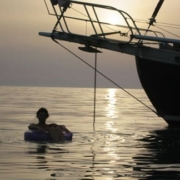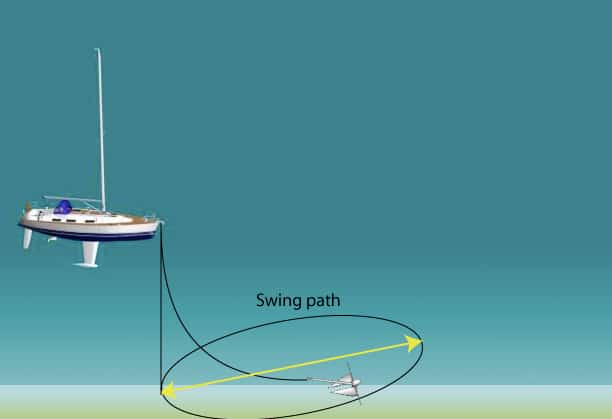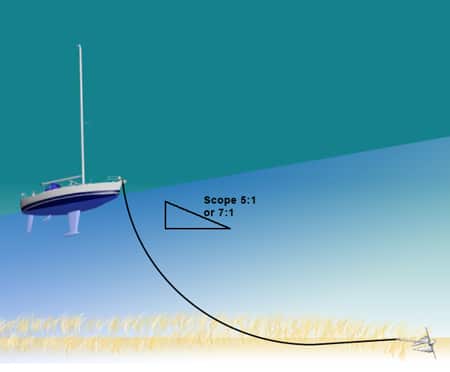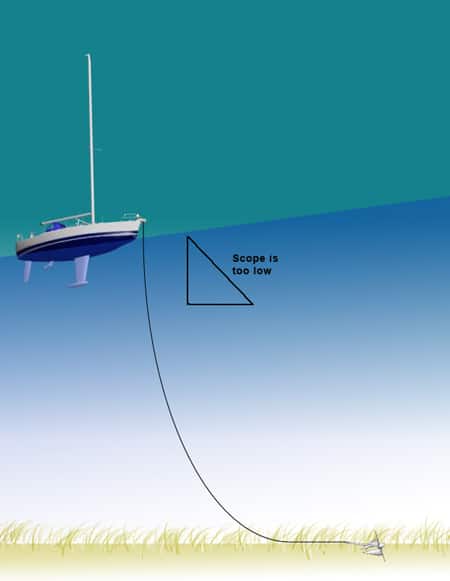Selecting an Anchoring Spot
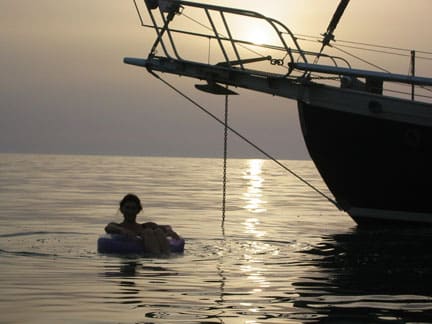
On this page we will cover:
- Selecting an anchoring spot
- Swing
- Considering the bottom
- Scope
Selecting an Anchoring Spot
Charts, both electronic and paper will tell you where the reliable anchoring spots are. The listing of these anchorage locations will depend on several factors: protection from swells, protection from weather, bottom type, and depth. But it doesn’t mean that these are safe for you at any particular time. You’ll need to choose the anchorage based on the conditions at the time and predictions of swell and weather change during your intended stay.
Depth is a major part in considering your anchoring position. And depth will vary with the tide. In a previous learn to sail article we discussed tide tables. As the tide goes out, you may find your boat lying on the bottom. As the tide comes in you may find that the original amount of rode you let out is no longer adequate. We’ll discuss this below in deploying the anchor.
Selecting a spot is also dependent upon other vessels anchored in the same anchorage area. You’ve got to give them enough room to not hit you as you both swing. They were there first and by convention – you must give them rights.
In a tight area, you can drop anchor directly behind the stern of another boat then as you drift back from the wind you’ll be far enough away from them to not bother them. As you both swing in the night it will be unlikely that you will bump into them.
On a typical day during the high charter season, mooring balls are claimed quickly, and late afternoon arrivals must secure the boat with the anchor. It is important to understand that boats first to arrive in an anchorage area have the right to select their anchoring sites and method of anchoring; later arrivals must respect this by adjusting their anchor swing areas to avoid impinging on those boats. This is especially concerning when other boats are moored with very small swing radii. Anyone in the same area intending to anchor must remember that their swing radius will be much larger than a moored boat, and take that into account when deploying the anchor. In general, don’t anchor in a mooring ball area because of that reason.
Swing
If you’ll be leaving the boat or staying overnight, you must assume that the wind will change direction up to 180 degrees in either direction. Therefore select an anchoring position that, considering the amount of rode you will let out, will not put you against a shallow area or hazards. Also, consider the tide when deciding this. IE you might be perfectly set with 20 ft (6m) of water below the keel. But if the wind changes you will swing around. Considering this you might still be in safe water, however compound this with 6 ft (2m) of tide and you could be high and dry on nasty rocks. See our section on reading tide charts in the Skipper Course.
You should consider that if you have let out 100 ft (30m) of rode, then with a wind change you could be almost 200 feet (60m) closer to shore or harbor obstacles.
Considering all the above, selecting an anchoring spot is not as simple as just “dropping the hook”.
Fortunately, other boats in the harbor will swing with you. The only variable here is what if they have a chain rode and used a 3:1 scope and you have a combination rode and used a 7:1 scope. In this case, your swing radius will be different – oops!
When considering tying up to other vessels overnight, also consider swing. If the wind clocks around, then your anchor rodes can become seriously tangled. So what if the wind clocked around and picked up dangerously? Now you have tangled anchor lines, big swells, and boats banging together in the middle of the night. Not good.
Considering the Bottom
Each bottom type has a different holding power. Your holding power against that bottom is also dependent on the anchor you select. If you’re chartering a sailboat on a sailing vacation then you will probably only have one type of anchor on board. Use the table below to consider the bottom against your anchor.
|
Anchor Type |
Best For |
OK for |
|
Danforth |
Sand, Mud |
|
|
Hinged Plough: CQR |
Sand, Rock, Mud, |
Clay, Grass |
|
Non-Hinged Plough: Delta |
Sand, Rock, Clay, Mud |
Grass |
|
Non-Hinged Plough: Roll Bar |
Sand, Rock, Mud, Clay, Grass |
|
|
Bruce |
Sand, Rock, Mud |
Clay, Grass |
The chart will tell you what kind of bottom you’re likely to encounter. Keep in mind however that the bottom type will vary throughout the known anchorage area. Locals will also tell you the type of bottom you are anchoring in.
Scope
Based on the depth, you will know how much rode to deploy. For a rope and chain combination rode, the standard reported conventional number to safely anchor without the expectation of dragging is 7 to 1. This means to deploy 7 feet of rode for every 1 foot of depth. To put it in perspective if the bottom is 20 feet (6m) then you should deploy 140 ft (42m) of rode. You’ll note immediately that this becomes impractical in some cases. Suffice it to say that if you know you’re deploying less than 7:1 then the likelihood of dragging in the night is high. This is why an all-chain rode is sometimes better. With all-chain you can deploy much less rode, as little as 3:1 or 4:1. Many charter sailboats supply an all-chain rode.
When considering depth you have to add the draft of your boat and the freeboard e.g. 10 ft (3m) indicated under your keel with a 5-foot draft and 4 feet of freeboard will give you a real “depth” of 19 ft. Now consider any safety offset that the charter company may have put into the depth meter – this is usually 5 feet so you’ve really got 24 ft (7m) of depth. The amount of rode to put out just went from 70 ft (21m) to 168 ft (49m). Wow!
Also, you can consider the conditions under which you are anchoring. Perhaps you’re just stopping for lunch and you will be staying on board and the wind is light and if there is little tide change during your stay. In this case, you could prudently use less than the 7:1 ratio for the combination rope and chain rode.
Consider also that your scope will change with the tide. Perhaps in the scenario below you have allowed for the correct scope.
But throughout the night, the tide has risen and the wind has picked up. Now look what has happened – oops.
And as mentioned above a falling tide may ground you or at least increase your swing into other obstacles. Be wary that you may need to change your scope throughout the night.

